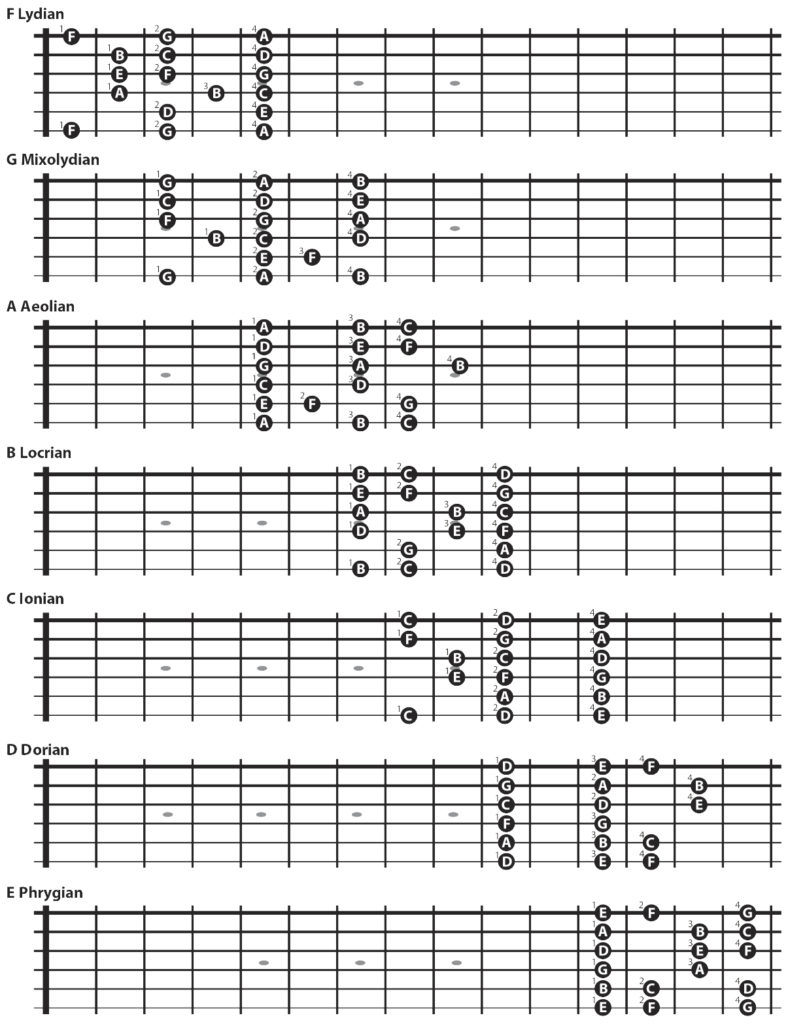The 7 In-Position Major Scale Fingerings
There are 7 in-position fingerings for every 7-note scale. You can basically start the scale from each one of the 7 notes of that scale on the low E string. This gives you 7 starting points.
Here are the 7 in-position fingerings for the C major scale:

The 7 different fingerings for the C major scale have the following names.
- C Ionian fingering
- D Dorian fingering
- E Phrygian fingering
- F Lydian fingering
- G Mixolydian fingering
- A Aeolian fingering
- B Locrian fingering
Keep in mind: these are merely names of the finger patterns, not necessarily names of scales.
Each one of these 7 fingerings, sounds like a C major scale when used over a C chord.
Each one of these 7 fingerings, sounds like a D Dorian scale when used over a Dm chord.
Each one of these 7 fingerings, sounds like an E Phrygian scale when used over an Em chord.
Each one of these 7 fingerings, sounds like an F Lydian scale when used over an F chord
Etc.
In other words:
- Each fingering can be 7 different scales… and at the same time…
- All 7 fingerings can be 1 scale.
Some Major Benefits to Learning In Position Scale Fingerings
The more diligent you are in following these scale fingerings and patterns to a T, the faster you will reap the benefits that these particular scale fingerings offer.
Here are some benefits you get out of the scale fingerings we’re covering today:
- “Structure”. Staying in position provides a certain structure that is not there with fingerings that cross over positions.
- Playing through changes. In-position scale fingerings make it easier to solo over more complex chord progressions or key changes where you have to change scale instantly on the spot. This has to do with how the in position fingerings divide the guitar neck up into 7 vertical blocks. This facilitates navigation through more complex key changes without getting lost.
- Sight-reading. These fingerings tremendously help with sight-reading and help to develop sight-reading skills.
- Feeling the note locations. One doesn’t have to look at the fingers while playing: all notes are right underneath the fingers when one stays in position.
- Better performance accuracy. Shifting sideways across positions, leads more easily to mistakes since every time one has to move sideways, there is a higher likelihood of mistakes happening due to the extraneous motion.
- It all comes together. There is an interval connection involved between staying in position, and interval knowledge application. Staying in 1 spot, you after a while start seeing how the scale and the whole fingering is a collection of stacked intervals, and scale and harmony knowledge come together. Not the case with sideways across position motion, which makes it harder to make all these connections because there is too much motion going on.
- Easier to learn other/new scales. The organizational aspect that is part of in position fingerings, gives you a huge advantage in learning new, other scales. After all: all scales are basically like “major scale fingerings with one or more notes moved up or down a half step somewhere”. The better someone gets these specific, structured fingerings down, the more easily one learns other new scales. Fingerings that move across different positions and that are hence “less structured”, don’t give that benefit. People who don’t know in position fingerings always spend way more time trying to master the fingerings of any new scale they learn.
How To Practice and Memorize these In Position Scale Fingerings
Play the F Lydian fingering up and down 4-5 times (or maybe a minute), ideally saying the note names out loud. Then solo over a C major song or backing track for 2 minutes, diligently using the fingerings as on the page.
After 2 minutes, move on to the next, Mixolydian fingering and do the same. 1 min learning the fingering, 2 minutes soloing.
Move on then to the Aeolian fingering, and so on.
This would add up to about 21 minutes of practice.
Do this every day till mastered.
Hit me up anytime at vreny@zotzinmusic.com if you would like me to email you a backing track, if you have any questions or if you would like to set up a lesson.
I’d gladly give you a discount.
You’re on your way to becoming a great guitar player.
Have fun with the new sounds! 🙂
Conclusion
Hit me up anytime at vreny@zotzinmusic.com if you have any questions, or if you would like to book a lesson.
These free lessons are cool, but you will never experience the progress, joy, and results that my students experience in lessons when you’re learning by yourself from blogs and videos.
That is why people take lessons: way better results and progress, much more complete information, exposed to way more creative ideas than you can get from a blog or YouTube video.
There is only so much that self-study can accomplish.
If you want to see amazing results and progress in your guitar playing, buy your first lesson here and get started ASAP.
You’ll impress your friends and loved ones in no time with your guitar playing!
Consider donating any small amount to help me keep this blog going.
Thank you for your support!


